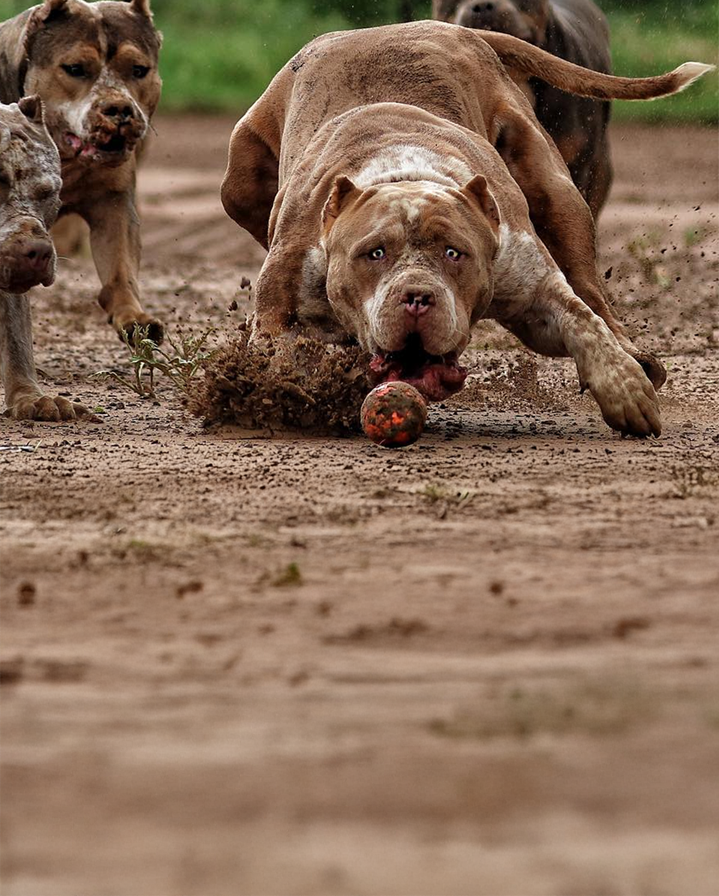How To Train an American Bully Dog
The American Bully is a modern breed of dog developed in the United States. The breed was recognized by the United Kennel Club in 2013 but has not yet achieved American Kennel Club recognition. Although many wonder 'Are American Bullies the same as Pitbulls?', they are in fact distinct breeds The American Bully is a companion dog who is loyal, protective and bonded to their owners. Because of their connection to people, American Bullies are very trainable. As such, they can excel in a variety of dog sports including Barn Hunt, Trick Dog, and Agility.
Unfounded stereotypes that American Bullies are dangerous or aggressive persist. In reality, they are strong but gentle dogs. When properly raised, trained, and socialized, these dogs can make wonderful family pets.

The Best Training Approaches for American Bullies
Like all other dogs, American Bullies learn best through positive reinforcement training methods. Positive reinforcement utilizes rewards when teaching new behaviors. These rewards include: treats, praise, toys, and play. You can also use positive reinforcement as part of behavior modification training.
Contrary to stereotypes, American Bullies do not need a "firm hand" when training. Aversive training tools like prong collars and e-collars should not be used.
Always be consistent with your training so your dog knows what to expect. The best training sessions are short and fun. A few short training sessions during the day are more effective than one long session.
Socialization Training Is a Must
Especially important when training American Bullies is socialization. This should start when they are puppies. Focus on appropriate introductions to new places, people, dogs, and other animals. Early socialization allows these dogs to make positive associations with new experiences.
As big strong dogs, American Bullies also need to learn basic obedience skills. This includes recall training or teaching a dog to come when called, and name recognition.
American Bullies should also learn not to pull on leash. To do this, reward your dog for walking next to you.
You'll also want to teach basic skills like sit, down, and stay.
Preventing and Interrupting Unwanted Behaviors
As much as possible, we want to set our dogs up for success. Create a home environment where your dog won't be able to do things you don't like.
Chewing is a natural behavior for dogs, but we don't want them to chew our belongings. Use baby gates to keep your dog in specific safe areas of the house.
Puppy-proof your house, by putting away shoes, children's toys and other things you don't want your dog to play with or chew.
Interrupt behavior you don't like by giving your dog something positive to do instead. If your dog is chewing something they shouldn't, take it away and give your dog an appropriate toy or chew. This approach is also effective if your dog or puppy mouths or bites at you while teething or in play.
Make sure your dog always gets enough attention and exercise and has access to toys and chews.
Training High Energy Dogs:
American Bullies are active dogs. This is not a breed happy to sit on the couch all day. American Bullies are great active family pets who enjoy hiking, play, and training. You can use playtime as an opportunity to practice and reinforce obedience skills.
Make sure your dog is getting enough daily physical and mental exercise. American Bullies whose exercise needs are met will be happier and calmer pets. Destructive behaviors like digging, chewing, and nuisance barking are common with bored dogs. When a dog's physical and mental enrichment needs are met, problem behaviors are reduced.
Getting Support on Training an American Bully:
When training your dog, it's helpful to work with a qualified dog trainer. Sign your young American Bully up for a puppy kindergarten class. Or, if you have an older dog, attend a basic obedience class to brush up on skills. Once your dog knows the basics, you can explore fun sports like Agility or Scent Work.
If you're struggling, consider private lessons with a dog trainer to work on issues. Working with a trainer is an opportunity for you to learn how to teach your dog in ways they understand. This can reduce frustration for both you and your dog.
Dog training is an unregulated industry, so anyone can call themself a dog trainer. Check references of any trainer to confirm that the trainer utilizes positive reinforcement methods.
Conclusion
Remember to reward your American Bully after training. It's essential for maintaining motivation and reinforcing positive behaviors.
At Bully Max, we understand the unique nutritional needs of bully breeds. That’s why we’ve developed a range of high-protein dog food and treats specifically tailored for them. Our products are designed to keep your dog healthy, energetic, and ready to learn.

We’d love to hear from you! Share your experiences and tips on training and rewarding your American Bully in the comments below.










11 comments
I’ve had quite a few large dogs in my life. (I’m 77) We got Khan as a 2 years old. He hadn’t had any training. He jumped on us and the kids, rushed the door, pulled us when walking him, etc. In the 2.5 months we’re had him He’s been the easier animal I’ve handled. He’s not finished by any means but I would recommend this breed completely.
I’m looking for someone who can give an expert opinion regarding and alleged Bully Dog bite. The picture of the alleged bite shows no teeth marks around the claimed bite. The pictures also show no penetration of the alleged clothing worn by the alleged victim. My opinion and experience is if an American Bully bit you, there would be more convincing evidence.
Need help to stimulate my Dog with toys. Seems not interested.
I noticed being firm did not work when training my American bully, when I’d play with her or giver treats, She responded better. Also, showing her what she did works really well.
Thank you